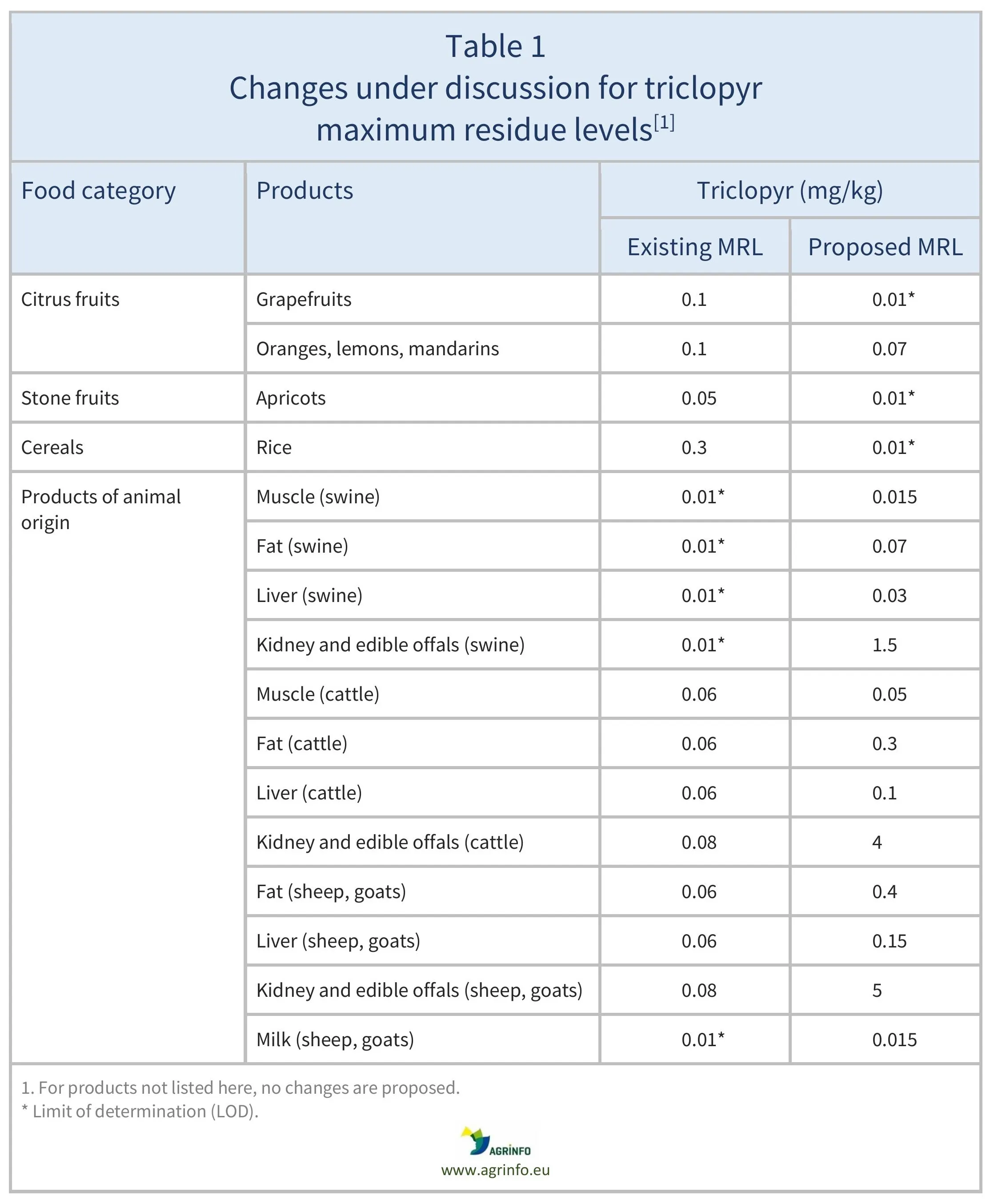Maximum residue levels for triclopyr
- Food safety
- Pesticide MRLs
Summary
The European Union (EU) is discussing amendments to the maximum residue levels (MRLs) for triclopyr on citrus fruits, apricots, rice, and animal products.
EU discusses amendment of triclopyr MRLs on certain products, with particular impact on citrus fruits, apricots, and rice
Draft Commission Regulation amending Annexes II, III and V to Regulation (EC) No 396/2005 of the European Parliament and of the Council as regards maximum residue levels for 1,4-dimethylnaphthalene, chlormequat, metribuzin, metribuzin-desamino-diketo (metribuzin-DADK), terbuthylazine and triclopyr in or on certain products
Draft Annex
Update
The European Union (EU) is discussing amendments to the maximum residue levels (MRLs) for triclopyr on citrus fruits, apricots, rice, and animal products.
Impacted Products
Grapefruits, oranges, lemons, mandarins, apricots, rice, animal products
What is changing?
The EU is discussing amending the MRLs for triclopyr on certain products as summarised in Table 1.
Why?
The MRLs for triclopyr were reviewed following assessments by the European Food Safety Authority (EFSA 2022, 2024), which confirmed that data gaps identified in earlier evaluations were resolved for apples, pears, and peaches, allowing the existing MRLs to be maintained. For other crops where data were still missing, including citrus fruits, apricots, and rice, the EU proposed to adjust the MRLs either to alternative safe levels proposed by EFSA, or to the product-specific limits of detection.
In addition, new MRLs are proposed for certain animal products based on recent applications and EFSA’s updated risk assessment confirming consumer safety (EFSA 2023).
Timeline
This Regulation is still under discussion. It is expected that new MRLs will apply from late 2026 or early 2027.
Recommended Actions
Suppliers of citrus fruits, apricots, and rice to the EU market should review their current use of triclopyr and start to seek alternative (chemical or non-chemical) solutions in anticipation of the MRL reductions.
Background
MRLs are set in accordance with the rules set out in Regulation 396/2005. For information on current MRLs for other substances, please consult the EU Pesticide Residues database.
For further information on the EU’s process and principles for setting MRL, see Regulation of pesticide residues in the EU – Questions and Answers
Resources
EFSA (2022) Modification of the existing maximum residue levels for triclopyr in oranges, lemons and mandarins. EFSA Journal, 20(8): 7545.
EFSA (2023) Modification of the existing maximum residue levels for triclopyr in animal commodities. EFSA Journal, 21(5): 8007.
EFSA (2024) Statement on the confirmatory data following the Article 12 MRL review for triclopyr. EFSA Journal, 22: e9176.
Sources
Draft Commission Regulation as regards maximum residue levels for 1,4-dimethylnaphthalene, chlormequat, metribuzin, metribuzin-desamino-diketo (metribuzin-DADK), terbuthylazine and triclopyr in or on certain products
Draft Annex
Tables & Figures

Source: based on PLAN/2025/1086_Rev1
Disclaimer: Under no circumstances shall COLEAD be liable for any loss, damage, liability or expense incurred or suffered that is claimed to have resulted from the use of information available on this website or any link to external sites. The use of the website is at the user’s sole risk and responsibility. This information platform was created and maintained with the financial support of the European Union. Its contents do not, however, reflect the views of the European Union.
EU discusses amendment of triclopyr MRLs on certain products, with particular impact on citrus fruits, apricots, and rice
Draft Commission Regulation as regards maximum residue levels for 1,4-dimethylnaphthalene, chlormequat, metribuzin, metribuzin-desamino-diketo (metribuzin-DADK), terbuthylazine and triclopyr in or on certain products
Draft Annex
What is changing and why?
The European Union (EU) is discussing amending the maximum residue levels (MRLs) for triclopyr (see Table 1). There will be particular impacts on citrus fruits, apricots, and rice.
Actions
Suppliers of citrus fruits, apricots, and rice to the EU market should review their current use of triclopyr and start to seek alternative (chemical or non-chemical) solutions in anticipation of the MRL reductions.
Timeline
This Regulation is still under discussion. It is expected that new MRLs will apply from late 2026 or early 2027.
Tables & Figures

Source: based on PLAN/2025/1086_Rev1
Disclaimer: Under no circumstances shall COLEAD be liable for any loss, damage, liability or expense incurred or suffered that is claimed to have resulted from the use of information available on this website or any link to external sites. The use of the website is at the user’s sole risk and responsibility. This information platform was created and maintained with the financial support of the European Union. Its contents do not, however, reflect the views of the European Union.
